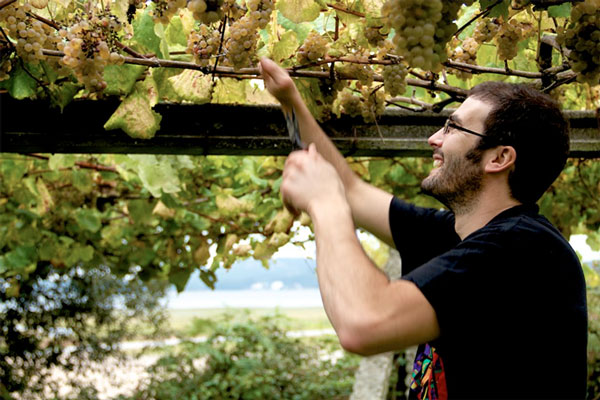Bodegas Albamar
VISIT IMPORTER'S WEBSITE
Country of Origin: Spain
Location: Cambados, Rías Baixas
People: Alba Family, Owners | Xurxo Alba, Winemaker
Viticulture: Practicing Organic
Items
If Sally sells seashells by the sea shore, Xurxo Alba of Albamar makes Albariño al alba del mar (next to the sea). If it were up to us, we'd stop right here. There's really not much more to say. It's what Xurxo was born to do. It's what he knows best. He is the personification of Albariño.
His cellar is in Cambados, next door to his parents' restaurant and tienda de ultramarinos, a small shop selling local artisan foods. His family has been farming and making Albariño in the O Salnés sub-region of Rías Baixas for generations. It wasn't until Xurxo finished his oenology studies that the Alba family started bottling and commercializing their wines in 2006.
The Alba family owns about 2.5 hectares but also sources from about 10 hectares spread throughout the region. Their winery and land is close to the Atlantic Ocean, near the mouth of the Umia River in the heart of Galicia's Rías Baixas. Xurxo wishes they owned more, but like their land, neighboring vineyards have been passed along from generation to generation. Working the land is a way of life; it's a hobby. It's what people do with their free time. It's a lifestyle in that money can't buy.
Xurxo farms and makes sure his farmers farm as naturally as possible, as much as the region permits. Being by the sea, the threat of fungal diseases like mildew and oidium is always present. In the cellar, spontaneous fermentation with native yeast is a common denominator between all of the wines. Whether he works the lees or uses oak is on a wine by wine basis, vintage by vintage.
Media Links
Spanish Wine Lover: Albamar Brings out the Freshness of Albariño
The New York Times: Your Next Lesson: Albariño
Featured in Decanter 2/2023: "Eight Rías Baixas Names to Know"
Wine Advocate 2/28/2022
"Xurxo Alba Padín planted a 0.3-hectare plot next to O Pereiro in 2021, and in 2020 he planted one hectare in a plot that he purchased in 2017 that was previously planted with eucalyptus trees. He asked for the change from eucalyptus to vines. Next to that new plot, he also has over four more hectares that he purchased in 2019 from three brothers and other relatives. There are hardly any five-hectare vineyards in the Salnés Valley, so he's going to have one of the largest vineyards in the zone. So far, he has only planted one hectare, but in the end, it will be more than five hectares planted in a single plot. And it's an amazing place in Castrelo, a parish of Cambados by the sea in a zone where there were tile factories in the past."
Wine Advocate 6/11/2020
"Most of the names that come to mind when we think of great Rías Baixas and great Albariño (but increasingly also red wines) originate in the Val do Salnés: Albamar, Do Ferreiro, Eulogio Pomares, Fulcro, Forjas del Salnés, Nanclares y Prieto, Narupa, Zárate… This is the zone with a true Atlantic/marine character and also the place with the most extreme fragmentation of the properties, with very small vineyards. 'Old-timers from Salnés never accepted the name Rías Baixas and didn’t agree about the other zones,' I was told more than once. 'They wanted to create an appellation for the Salnés rather than putting together different zones that don’t have that much in common. But Rías Baixas was created and that was that.' In 1988, when the appellation was created, there were three subzones; they added Soutomaior in October 1996, and then it was expanded again in May 2000 with the Ribeira do Ulla."
Wine Advocate 2/28/2019
"Xurxo Alba Padín is an explosion of energy and doesn't stop experimenting. He showed me a great unsulfured Albariño and a white made from red Caíño grapes. His 2017s are very classical, with less structure than the 2015s but very good freshness, fresher than the 2016s even though 2017 was a warmer vintage."
Wine Advocate 8/31/2017
"Xurxo Alba Padín from Albamar is expanding to other zones of Galicia, Valdeorras and Ribeira Sacra and has expanded his red range in Rías Baixas to the three varieties. The 2015 whites are phenomenal, especially my favorite, 69 Arrobas. I tasted with him and visited some of his vineyards. He is one of the guys to watch."

